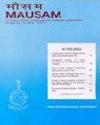Modelling spatiotemporal tendencies of climate types by Markov chain approach : A case study in Sanliurfa province in the south-eastern of Turkey
IF 0.7
4区 地球科学
Q4 METEOROLOGY & ATMOSPHERIC SCIENCES
引用次数: 1
Abstract
Identification of spatiotemporal tendencies of climate types may help water managers mitigate the negative impacts of droughts on water-demanding sectors. The primary objective of this study was to figure out the spatiotemporal tendencies of climatetypes in Sanliurfa province by using Erinc’s aridity index (EDI). To that end, long-term (1965-2018) annual precipitation and average annual maximum temperature series of meteorological stations were obtained and utilized to calculate the EDI series on a yearly basis. The EDI series of each station was divided into three periods, non-overlapping and successive, i.e., P1 (1965-1981), P2 (1982-1999) and P3 (2000-2018). Outliers were detected, andremoved from the EDI series; missing data were completed by regression analysis. The Markov transition probability matrix of the climate classes for the three periods was estimated for each station. Maps of the initial probability vectors and steady-state probabilities for the three periods of each climate class were generated by the inverse distance-weighted technique. Hypsometric curves for each climate class, as well as period, were developed and areal coverage of occurrence probabilities (OP) was determined. Results indicated that, as time progressed, the areal extent of severe-arid and arid climatic classes continued consistently to spread from the south to the north. Areas of semi-arid climate type showed a slight tendency towards the arid-climate type. Construction of large dams in the region could not prevent the shifts in the climate in favour of developing arid zones. The humid climate class is likely to vanish away in the future. Research led us to conclude that the expansion of the aridzone from south to northhas been alarming in terms of the adequacy of water resources. It is strongly recommended that spatiotemporal climate change studies should be periodically conducted in tandem with forest management practices for the region.用马尔可夫链方法模拟气候类型的时空趋势——以土耳其东南部Sanliurfa省为例
识别气候类型的时空趋势可以帮助水资源管理者减轻干旱对需水部门的负面影响。本研究的主要目的是利用Erinc干旱指数(EDI)分析三流法省气候类型的时空变化趋势。为此,获取气象站长期(1965-2018)年降水量和年平均最高气温序列,并利用其计算年际EDI序列。各站的EDI序列划分为P1(1965-1981)、P2(1982-1999)和P3(2000-2018)三个不重叠且连续的时期。检测到异常值,并从EDI系列中删除;通过回归分析补齐缺失资料。估计了各台站三个时期气候类别的马尔可夫转移概率矩阵。每个气候类别的三个时期的初始概率向量和稳态概率图是通过逆距离加权技术生成的。建立了各气候类别和时期的等温曲线,并确定了发生概率(OP)的面积覆盖。结果表明,随着时间的推移,严重干旱和干旱气候等级的面积范围持续从南向北扩展。半干旱气候型地区向干旱气候型转变的趋势较弱。在该地区建造大型水坝并不能阻止气候向有利于发展干旱地区的方向转变。湿润气候类很可能在未来消失。研究使我们得出结论,就水资源的充足性而言,干旱区从南向北的扩张令人担忧。强烈建议将时空气候变化研究与该区域的森林管理做法结合起来定期进行。
本文章由计算机程序翻译,如有差异,请以英文原文为准。
求助全文
约1分钟内获得全文
求助全文
来源期刊

MAUSAM
地学-气象与大气科学
CiteScore
1.20
自引率
0.00%
发文量
1298
审稿时长
6-12 weeks
期刊介绍:
MAUSAM (Formerly Indian Journal of Meteorology, Hydrology & Geophysics), established in January 1950, is the quarterly research
journal brought out by the India Meteorological Department (IMD). MAUSAM is a medium for publication of original scientific
research work. MAUSAM is a premier scientific research journal published in this part of the world in the fields of Meteorology,
Hydrology & Geophysics. The four issues appear in January, April, July & October.
 求助内容:
求助内容: 应助结果提醒方式:
应助结果提醒方式:


